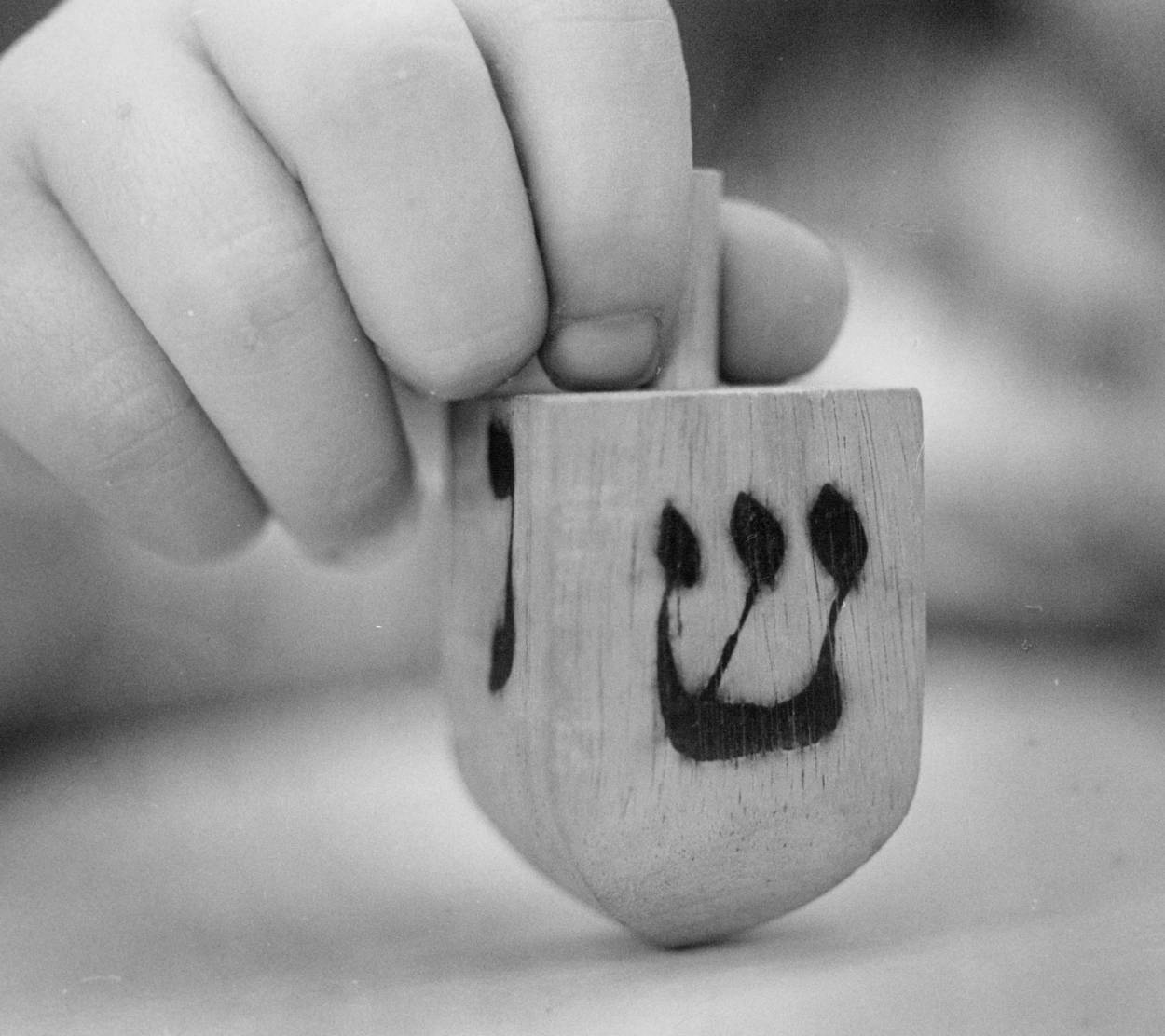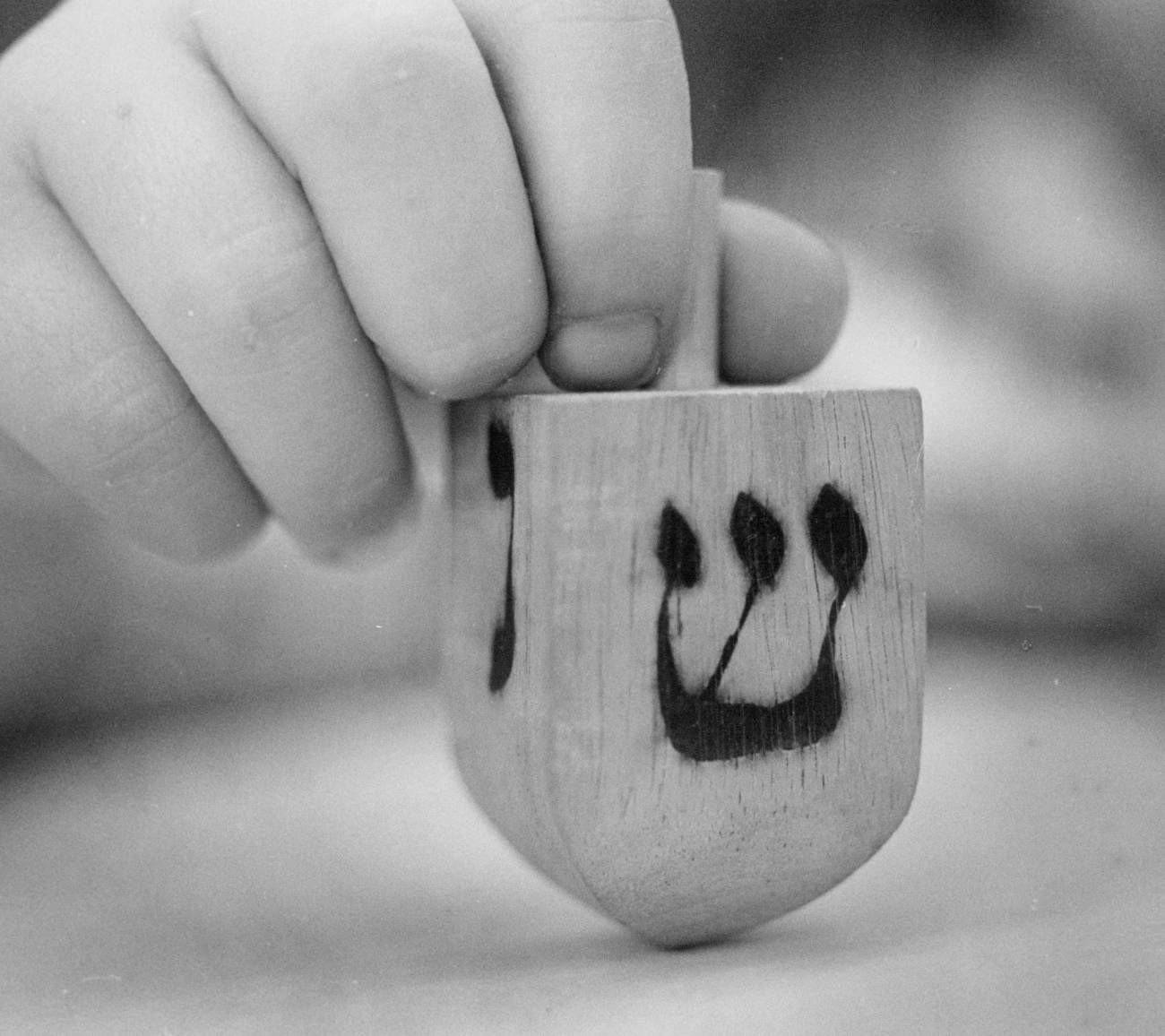Adapt, Adopt, Subvert, Survive
As the humble dreidel proves, the story we know isn’t even half the story of Hanukkah




My grandparents never played dreidel back in Aleppo. Why would they? Hardly anyone in Arabic- and Persian-speaking lands had ever heard of this Yiddish word, let alone celebrated Jewish victory by gambling. Legend has it that Jews under Seleucid Greek persecution would secretly study Torah, and when the authorities barged in, they would hide their Torah scrolls and take out their dreidels. This legend, however, has no backing in any ancient source and the earliest mention of a dreidel in a Jewish context dates only from the 18th century. In fact, the Yiddish game derives from a European gambling game called teetotum in England and its equivalent in Germany, where the spinner bears the letters N(ichts), G(anz), H(alb), S(tellein).
But while the humble dreidel has received some bad press in recent years, I actually think it is a perfect symbol for Jewish survival, even worthy of adorning the Jewish Children’s Museum. To explain why, let’s reexplore the Hanukkah story.
The standard narrative of Hanukkah pits the Hellenizing assimilated Jews against the traditionalist zealot Hasmoneans. The Hellenizing high priests Jason and Menelaus built a gymnasium in Jerusalem, encouraged Greek acculturation, and introduced paganism into the Temple. The Hasmoneans and their followers fought tooth and nail for strict observance of Jewish law and the complete excision of anything Greek. The Hasmoneans successfully rooted out the assimilationists and restored a Judaism as pure as a sacred cruse of oil. Here is how the Haredi historian Rabbi Berel Wein concludes his summary:
What happened to the Hellenists? Their influence all but collapsed in the wake of the defeat. They would never return again as Hellenists, because the war brought out their true colors as traitors and they lost whatever appeal they could have had to the Jewish people. … They were just not part of the Jewish people any longer.
It’s the ancient parallel to the modern tension between assimilated anti-religious Hilonim, or secular Jews, against the ultra-zealous Haredim or Hasidim, and there may be some truth to this parallel. For better or for worse, however, it is simply not historically accurate that the Hellenists admitted defeat and disappeared from history.
Rather, a more realistic narrative grounded in primary sources reveals that the Hasmoneans and their followers bore many stamps of Greek acculturation themselves. Unlike later Bar Kochba coins that featured menorahs and other Temple imagery, Hasmonean currency displayed helmets, anchors, sunwheels, and the cornucopia, a symbol right out of Greek mythology. Yes, the Maccabees demanded Temple purity, destroyed idols, killed fellow Jews who agreed to practice pagan rites, and fought for autonomy and religious freedom. At the same time, they and their followers incorporated many aspects of Hellenistic society into their own practice and approach.
For example, a primary source for the lead-up to the war and to Judah the Maccabee’s victory is the apocryphal work 2 Maccabees, which was written in Greek language and in the style of Greek historiography, including rhetorical orations and dramatic storytelling. In this spirit, it includes heart-wrenching retellings of torture that appeal to readers’ pathos, like the story of the mother watching her seven sons martyr themselves with stoic resolution. Similarly, it narrates that when the Hellenizers forced Eleazar the elderly priest to eat pig or die, he willingly martyred himself, even when the guards offered to substitute the pig for kosher meat so that he would only look like he was sinning while not actually transgressing. His willingness to die to make a public educational point even when thrown a lifeline, recalls Socrates who similarly accepts capital punishment even when offered an escape plan by a friend. The author of 2 Maccabees thus draws inspiration from a Greek philosophical hero to demonstrate the courageous dedication of this pious Jew in his fight against Greek assimilation itself. Ironic but effective.
Turns out, the choices for a religious minority seeking to survive in a dominant empire are not just the extreme options of rejection or assimilation. Instead, the smaller group can decide to adopt, adapt, incorporate, imitate, modify, mock, subvert, convert, or Kedushify (make holy) the practices, ideas, and forces of the world around them.
As another example of this strategy, the date of Hanukkah on the 25th of Kislev was not actually the day the Maccabees won the battle or gained control of the Temple, which they had already been busy purifying for several weeks before. Rather, 2 Maccabees 10:5 informs us that this date was chosen because it was precisely the date of the altar’s defilement: “It happened that on the same day on which the sanctuary had been profaned by the foreigners, the purification of the sanctuary took place, that is, on the twenty-fifth day of the same month, which was Chislev.” In fact, that date was likely chosen by the pagans to celebrate the Greek winter solstice festival called the Feast of Poseidon, which eventually became the Roman festival of Saturnalia commemorated on, you guessed it, Dec. 25. Instead of canceling this Greek festival, the Hasmoneans transformed the hedonistic pagan ritual into a monotheistic holy commemoration of God’s providential protection and Jewish survival. The increasing lamps of each night may derive from the increasing daylight after the solstice; but in the new context, the growing light symbolizes increasing hope for redemption even during the darkest moments of persecution.
In modern times, the Maccabees’ fame continues in the millions of hits for the Maccabeats, who Kedushify popular hip-hop songs by replacing their racy lyrics with themes of Jewish history and piety. Or look to the name of the worldwide Maccabiah games, the Jewish Olympics, held every four years in Israel. The Maccabees is also the name of Yeshiva University’s spectacular basketball team. Is Judah the Maccabee rolling in his grave thinking that he died on the battlefield fighting against Greek athletics and the influence of the gymnasium in Jerusalem only to have his name become synonymous with sports? To the contrary, I believe he would be satisfied that these athletes, now fully clothed, adapted competitive sports as a means to express their Jewish pride and strengthen their national allegiance. No better way to fight acculturation than to convert and purify it for good.
Historian Elias Bickerman, author of From Ezra to the Last of the Maccabees, summarized the Hasmonean achievement thus:
Judaism was able to enrich itself with new and foreign ideas and to be saved from the mummification that overtook the religion of the Egyptians, for example, which shut itself off from Hellenism completely. The Maccabees preserved the Judaism of the Greek period from both dissolution and ossification. It is through their deeds that the God of Abraham, Isaac, and Jacob could and did remain our God.
This strategy kept Judaism thriving in every generation, weathering physical and philosophical attacks alike. Maimonides viewed Greek philosophy not as a threat to revealed religion but rather as a way to test, purify, and strengthen Jewish received ritual and tradition. In modern times, American Jews wanting to alleviate their own kids from feeling jealous of Christmas presents, joined the holiday spirit and invented Hanukkah gift-giving. Every year, my extended family uses elfster.com to arrange our own Hanukkah grab bag without any notice of the irony. What better way to demonstrate the power of subverting the forces of assimilation!
It is for this reason that I love how the German letters on a gambling spinner have been transposed into Hebrew: N(es) G(adol) H(ayah) Sh(am)—A Great Miracle Happened There. Jewish communities put a winning spin on this foreign game, already widely popular during long winter nights, and Judaized it as a symbol of resilience and victory. If the Maccabean martyrs were here today, I believe they would impart this wisdom: Don’t assimilate to the current fads nor isolate behind high walls. Instead, incorporate all that is worthy wherever you find it, adopt what is good, adapt what is not and, in the spirit of the Maccabees, Kedushify the world.
Rabbi Dr. Richard Hidary is a professor of Judaic Studies at Yeshiva University, a rabbi at Sephardic Synagogue, and a faculty member for the Wexner Heritage Program. He was recently a Starr fellow at Harvard University’s Center for Jewish Studies and a Clal - LEAP fellow at the Katz Center for Advanced Jewish Studies, University of Pennsylvania. He is the author of Dispute for the Sake of Heaven: Legal Pluralism in the Talmud (Brown University Press, 2010) and Rabbis and Classical Rhetoric: Sophistic Education and Oratory in the Talmud and Midrash (Cambridge University Press, 2018). He is currently writing a new translation and commentary on tractate Sanhedrin and recording daf yomi classes (available on YouTube). He also runs the websites teachtorah.org, pizmonim.org, and rabbinics.org.